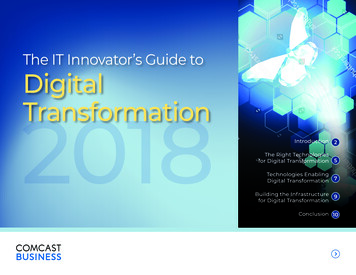
Transcription
The IT Innovator’s Guide toDigitalTransformation2018Introduction 2The Right Technologiesfor Digital Transformation 5Technologies EnablingDigital Transformation 7Building the Infrastructure 9for Digital TransformationConclusion 10›
IntroductionIt’s no secret that most companies that resist change won’t survive intoday’s economy. Today’s fast-paced, digital environment requires companies to move beyond their status quo to outpace their competitors, beforetheir competitors outpace them.Unfortunately, however, companies that have found success in the past tend tobe reluctant to make changes to their business models. Their fear—whether it’sof “breaking something” or of the unknown—can be a company’s undoing, assuccess favors the innovative.A growing number of companies are realizing the importance of digitaltransformation in their strategy for success. According to a survey of ITdecision-makers by IDG, 37 percent of respondents have begun integratingand executing a digital-first approach and 7 percent consider themselvesTHE IT INNOVATOR’S GUIDE TO DIGITAL TRANSFORMATION, 2018›2
› INTRODUCTIONan enterprise-wide digitalbusiness. About half (45 percent) ofrespondents have begun the journeyto becoming a digital business.1What’s more, of those companies thathave adopted a digital-first approach,32 percent of respondents said digitalbusiness has already helped increasetheir company’s revenues.2The bar continues to move for digitaltransformation: What started asdigital initiatives with social, mobile,analytics and cloud has given wayto a digital transformation journeywhere digital-first thinking hasbecome a business imperative, andnew technologies are driving newopportunities.Digital transformation is imperativefor survival in today’s economy. Yet,it is not the same for every company;each has different reasons fortransforming, and each incorporatesdifferent technologies, differentprocesses and different mindsets toachieve digital transformation.Indeed, the catalyst for digitaltransformation is different forevery company, but in general,organizations turn to digitaltransformation to:Support growing use of cloudbased services or other nextgeneration technologies:Increasingly, cloud and softwarebased offerings such as softwaredefined networks are becoming thetechnologies used in companies ofevery size and vertical. The ease ofmanagement—including the abilityto scale up or down as necessaryand access to the latest versionof applications and services—ispushing many organizations toadopt a software-first or cloud-basedstrategy for their new technologyimplementations.Digital TransformationWell Underway37%45%37 percentof companieshave begunintegratingand executinga digital-firstapproach45 percentof companieshave begunthe journeyto becominga digitalbusinessSource: “2018 State of Digital Transformation,” white paper, IDGCommunicationsIncrease employee productivitythrough new technologies andservices: In addition to cloud andsoftware-based technologies, aplethora of new offerings are makingTHE IT INNOVATOR’S GUIDE TO DIGITAL TRANSFORMATION, 2018›3
› INTRODUCTIONtheir way into the workplace tobetter enable employees to not onlywork faster, but smarter. Artificialintelligence, big data analytics andautomation are some examples ofsuch technologies.Improve customer satisfaction andloyalty: New-generation technologieshelp companies improve employeeproductivity and meet or exceedcustomer expectations, improvingcustomer satisfaction and loyalty inthe long term.Companies that have undergone a digitaltransformation, embracing new technologies andadapting their processes to be more technology-centric, arethose that are finding successRetain or gain a competitive edgeover competitors: Companiesthat have undergone a digitaltransformation, embracing newtechnologies and adapting theirprocesses to be more technologycentric, are those that are findingsuccess over their slower, less agilecompetition. By the same token,companies that don’t adopt a digitaltransformation strategy will finditself struggling to keep up, muchless succeed in today’s businessenvironment.THE IT INNOVATOR’S GUIDE TO DIGITAL TRANSFORMATION, 2018›4
The RightTechnologiesfor DigitalTransformationWhile every digital transformation rollout is different, with different technologies and processes depending on the company and its goals, at theheart of every undertaking is an infrastructure designed to help companies work smarter, faster and more efficiently. That includes technologiesthat streamline processes, improve productivity and enhance the customer experience.Cloud computing—be it public,private or hybrid—is an importantelement in any network supporting adigitally transformed company. Morethan half (53 percent) of respondentsin the IDG survey have implementedprivate cloud, while 45 percent haveimplemented public clouds.3The benefits of cloud environmentsare numerous and well-known.Flexibility, scalability, agility andcost efficiencies are some of themore obvious benefits that drawcompanies to cloud services.In digital transformation, cloudprovides a secure environment inwhich companies can continuouslyinnovate—such as with DevOps—andcollaborate—such as with disparateTHE IT INNOVATOR’S GUIDE TO DIGITAL TRANSFORMATION, 2018›5
› THE RIGHT TECHNOLOGIES FOR DIGITAL TRANSFORMATIONteams and locations.Much like the cloud, softwaredefined networking (SDN) enablesnetworks to be managed dynamicallyand scale according to capacity needsto ensure company networks alwaysrun at peak efficiency. Accordingto an Information Age article: “SDNgives enterprises access to a moresophisticated network feature setand service experience that helpimprove operational efficiency byimplementing functionality at thespeed of software.”4Companies that have embraceddigital transformation understand thepower SDN can provide in creatingand supporting a digital-first strategy.Indeed, almost half of respondentsto IDG’s survey said they are pilotingor researching SDN, or it is on theirradar, to implement within the next 12months.5Mobile technology, too, is a majordriver in digital transformation—and for many companies is themajor disruptor forcing a changein business strategy. IDG’s surveynotes 59 percent of respondentshave already adopted mobiletechnology in their business. As thenumber of mobile users and thenumber of enterprise-ready mobileapps continue to rise, companiesmust include mobile as part of theirongoing business strategy.6Big data/analytics, noted by 59percent of IDG survey respondents,and APIs, noted by 40 percent ofrespondents, make up the “Top5” digital technologies alreadyimplemented. Both are integral inhelping organizations make smarterbusiness decisions faster.Cloud Adoptionon the Rise53 percent ofcompanies haveimplementedprivate cloud45%53%45 percent ofcompanies haveimplementedpublic cloudSource: “2018 State of Digital Transformation,” white paper,IDG CommunicationsTHE IT INNOVATOR’S GUIDE TO DIGITAL TRANSFORMATION, 2018›6
, digital transformation isn’t achieved simply by adopting cloud,SDN and mobile and other core technologies. As each organization’s digital transformation journey is different, the technologies used to enabledigital transformation at each organization also will be different.Edge computing is a hallmark technology of companies that have adopteddigital transformation, especially among those that rely heavily on theInternet of Things (IoT). The multitude of IoT devices on a network, eachcommunicating with other devices and providing relevant data, will needresponse and processing in real time to provide true value to the organization.Edge computing has emerged as a way to make that happen, enablingcompanies to harness the power of data analytics for faster and moreinformed decision-making.THE IT INNOVATOR’S GUIDE TO DIGITAL TRANSFORMATION, 2018›7
› TECHNOLOGIES ENABLING DIGITAL TRANSFORMATIONIoT Findinga Place49%49 percent of IT decision-makers have included IoTin their digital business strategySource: “2018 State of Digital Transformation,” white paper, IDG CommunicationsAutomation is helping manyorganizations become more agileby reducing the amount of timeand energy employees must spendmanually performing tasks. Digitallytransformed companies can utilizeautomation in everything frommarketing to IT services, freeingemployees to spend their time onactivities to further the business,such as finding new customersor promoting new products andservices. Automation also can helporganizations reduce downtimeand increase the security of theirnetworks and infrastructure throughsystematic, repeatable processes.Artificial intelligence, meanwhile, isswiftly emerging as a technology capable of serving organizations of all sizesin all markets. AI can be used for a widerange of activities, from determiningmore efficient business processes tocreating personalized services basedon user preferences and past behaviors. The benefits of AI are far-reaching,enabling companies to push into newmarkets, target new customers andcreate new products and services—all backed by a level of intelligencefomented by AI technologies.Many companies looking toharness the benefits of artificialintelligence also are turning tomachine learning to help promoteAI within their business strategy.Machine learning—providing datato machines to let them learn forthemselves—is the current stateof the art for artificial intelligence.Using machine learning, systemscan “understand” whether customercomments on a company website orsocial media site are positive reviewsor negative complaints—and respondappropriately—or can re commendadditional items to purchase on awebsite based on a shopper’s buyinghabits, for example.Finally, the Internet of Things (IoT),already nearing ubiquity in the consumer space, is growing as an important driver for business intelligence.IoT devices are able to collect massiveamounts of data from multiple sources to understand customer behaviors,track inventory in building and intransit, and provide insight into theway employees work, with the idea ofdeveloping better business processes.In IDG’s survey, 49 percent of IT decision-makers have included IoT in theirdigital business strategy.7THE IT INNOVATOR’S GUIDE TO DIGITAL TRANSFORMATION, 2018›8
Digital transformation requires an infrastructure that is capable of supporting multiple technologies both on-premises and in the cloud and canmanage the massive data storage and back-and-forth transport that manytransformative technologies require.Building theInfrastructurefor DigitalTransformationIn a digital transformationDigital transformation won’t—orworld, “smarter” plays a leadingcan’t—happen overnight. To helprole—technologies are enablingorganizations on their journey tobusinesses to move at light speeddigital transformation without overlyand be smarter in meeting evolvingstressing their current networkcustomer expectations. Organizations,and to streamline processes for ITtherefore, need an environment thatmanagers during and after the digitalsupports digital transformation fromtransformation, managed servicesevery point on the network. Hybridcloud and network environments,SD-WAN and high-speed broadbandare just some of the technologiescan help tie disparate systemstogether and “fill in the gaps” ascompanies update their currentinfrastructure and after networksthat can enable companies to betterhave been upgraded.manage their business applicationsWorking with a network serviceacross all locations, while networkingprovider can help ease the burdencomponents such as WiFi andassociated with building andunified communications can ensuremaintaining a network capable ofemployees can work anytime,handling the all aspects of digitalanywhere, with no impact ontransformation to help companiesproductivity.move “beyond fast.”THE IT INNOVATOR’S GUIDE TO DIGITAL TRANSFORMATION, 2018›9
ConclusionIn today’s fast-paced business environment, companies can’t afford tomaintain their status quo. To remain competitive and thrive, organizationsmust transform before their competitors gain the advantage.Digital transformation is imperative for survival in today’s economy, asprocesses and applications become more digital-centric. For many companies,what started as digital initiatives with social, mobile, analytics and cloud hasevolved a digital transformation journey in which digital drives business andnew technologies drive new opportunities.At the heart of every undertaking is an infrastructure designed to helpcompanies work smarter, faster and more efficiently. That includestechnologies that streamline processes, improve productivity and enhance thecustomer experience—all with the end goal of creating a more efficient andcustomer-focused organization that moves beyond fast.THE IT INNOVATOR’S GUIDE TO DIGITAL TRANSFORMATION, 2018›10
›The IT Innovator’s Guide to Digital Transformation, 20181 “2018 State of Digital Transformation,” white paper, IDG Communications2 Ibid3 Ibid4 Nick Ismail, “Ten reasons for embracing SDN as part of digital transformation,” Information Age, Aug. 11, 2017, ing-sdn-part-digitaltransformation-123467838/5 “2018 State of Digital Transformation,” white paper, IDG Communications6 Ibid7 Ibid 2018 Comcast. All rights reserved.
new technologies are driving new opportunities. Digital transformation is imperative for survival in today’s economy. Yet, it is not the same for every company; each has different reasons for transforming, and each incorporates different technologies, different processes










